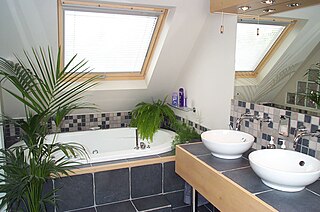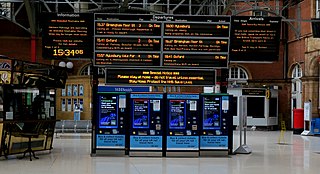
A garden office is an office in a garden outbuilding. [1] This is usually separate to a house, being used as a dedicated office space by a remote worker or by a home-based business.

A garden office is an office in a garden outbuilding. [1] This is usually separate to a house, being used as a dedicated office space by a remote worker or by a home-based business.
In the UK, planning permission is not normally needed for a garden office if you are only using it as a home study and if it is similar in size and construction to a garden shed. A garden office used as a home study does not need planning permission as long as it is not more than 4 metres tall for a pitched roof, at least 2 metres from the property line and does not cover more than half of the garden area. If you are running a business from your garden office it will need planning permission regardless of its size or position within the garden. This is because working at home, in the garden, can cause a problem for neighbours. The cost will depend upon the facilities and can be between £5,000 and £60,000. Internet and telephone connections may be required and this can perhaps be achieved by use of a wireless network based in the main building. [2] [3]
Garden offices boomed in popularity during COVID-19 lockdowns and working-from-home. [4] They have been related to outbuildings such as sheds. [5]


A shed is typically a simple, single-story roofed structure, often used for storage, for hobbies, or as a workshop, and typically serving as outbuilding, such as in a back garden or on an allotment. Sheds vary considerably in their size and complexity of construction, from simple open-sided ones designed to cover bicycles or garden items to large wood-framed structures with shingled roofs, windows, and electrical outlets. Sheds used on farms or in the industry can be large structures. The main types of shed construction are metal sheathing over a metal frame, plastic sheathing and frame, all-wood construction, and vinyl-sided sheds built over a wooden frame. Small sheds may include a wooden or plastic floor, while more permanent ones may be built on a concrete pad or foundation. Sheds may be lockable to deter theft or entry by children, domestic animals, wildlife, etc.

Croxteth Hall is a country estate and Grade II* listed building in the West Derby suburb of Liverpool, England. It is the former country estate and ancestral home of the Molyneux family, the Earls of Sefton. After the death of the seventh and last Earl in 1972, the estate passed to Liverpool City Council, which now manages the remainder of the estate following the sale of approximately half of the grounds. The remaining grounds, Croxteth Park, were at one time a hunting chase of the Molyneux family and are now open to the public.

Welwyn Garden City is a town in Hertfordshire, England, 20 miles (32 km) north of London. It was the second garden city in England and one of the first new towns. It is unique in being both a garden city and a new town and exemplifies the physical, social and cultural planning ideals of the periods in which it was built.

Harlow is a town and local government district located in the west of Essex, England. Founded as a new town, it is situated on the border with Hertfordshire, and occupies a large area of land on the south bank of the upper Stort Valley, which has been made navigable through other towns and features a canal section near its watermill.

Planning permission in the United Kingdom is the planning permission required in the United Kingdom in order to be allowed to build on land, or change the use of land or buildings. Within the UK the occupier of any land or building will need title to that land or building, but will also need "planning title" or planning permission. Planning title was granted for all pre-existing uses and buildings by the Town and Country Planning Act 1947, which came into effect on 1 July 1948. Since that date any new "development" has required planning permission.

A tree house, tree fort or treeshed, is a platform or building constructed around, next to or among the trunk or branches of one or more mature trees while above ground level. Tree houses can be used for recreation, work space, habitation, a hangout space and observation. People occasionally connect ladders or staircases to get up to the platforms.
Town and country planning in the United Kingdom is the part of English land law which concerns land use planning. Its goal is to ensure sustainable economic development and a better environment. Each country of the United Kingdom has its own planning system that is responsible for town and country planning, which outside of England is devolved to the Northern Ireland Assembly, the Scottish Parliament and the Senedd.

A bothy is a basic shelter, usually left unlocked and available for anyone to use free of charge. It was also a term for basic accommodation, usually for gardeners or other workers on an estate. Bothies are found in remote mountainous areas of Scotland, Northern England, Ulster and Wales. They are particularly common in the Scottish Highlands, but related buildings can be found around the world. A bothy was also a semi-legal drinking den on the Isle of Lewis. These, such as Bothan Eòrapaidh, were used until recent years as gathering points for local men and were often situated in an old hut or caravan.
Building regulations in the United Kingdom are statutory instruments or statutory regulations that seek to ensure that the policies set out in the relevant legislation are carried out. Building regulations approval is required for most building work in the UK.

The Town and Country Planning (England) Order 2015 is a statutory instrument, applying in England, that grants planning permission for certain types of development without the requirement for approval from the local planning authority.

The Garden Bridge project was an unsuccessful private proposal for a pedestrian bridge over the River Thames in London, England. Originally an idea of Joanna Lumley, and strongly supported by then-Mayor of London Boris Johnson, the designer Thomas Heatherwick worked with Arup Group on a proposal by Transport for London (TfL) for a new bridge across the Thames between Waterloo Bridge and Blackfriars Bridge. The proposed concrete, steel, cupronickel clad structure was intended to carry pedestrians, with no cycles or other vehicles. It was to have been located some 200 metres (660 ft) from Waterloo Bridge and 300 m (980 ft) from Blackfriars Bridge, and have included some areas of planting. The project was to include a commercial building, built on former green space at the southern end of the bridge. The bridge was intended to be funded by raising over £140 million of private money and £60 million of promised public money, of which £30m was from Transport for London and £30m from the Department for Transport, adding up to projected funding of over £200m. In January 2017, the trustees of the prospective owner of the bridge, the Garden Bridge Trust, stated that costs would "substantially exceed" an earlier revised total of £185m and, in April 2017, a report by Margaret Hodge MP concluded, on the basis of the Garden Bridge Trust's own evidence, that the cost would be over £200m.

The Maidstone Studios, formerly called TVS Television Centre, is the largest independent television studio complex in the United Kingdom, and is based at Vinters Park in Maidstone, Kent, England. It has been home to a varied selection of independent British television programming including Later... with Jools Holland, Jools' Annual Hootenanny, Take Me Out, Catchphrase, as well as popular children's shows such as Mister Maker and Let's Play for CBeebies, or Art Attack for TVS and later for ITV and Disney Channel.

The Banks Group Limited is a family owned business headquartered in Durham, but working across Scotland and the North of England, established in 1976. Banks develops and operates in a variety of business areas including property development, renewables generation, flexible energy generation and storage, and mineral extraction and infrastructure services. The Banks Group was founded by Harry Banks OBE DL with his brothers Graham Banks, Joe Banks and Bruce Banks.

A loft conversion or an attic conversion is the process of transforming an empty attic space or loft into a functional room, typically used as a bedroom, office space, a gym, or storage space. Loft conversions are one of the most popular forms of home improvement in the United Kingdom as a result of their numerous perceived benefits.
In the United Kingdom, the term conservation area almost always applies to an area of special architectural or historic interest, the character of which is considered worthy of preservation or enhancement. It creates a precautionary approach to the loss or alteration of buildings and/or trees, thus it has some of the legislative and policy characteristics of listed buildings and tree preservation orders. The concept was introduced in 1967, and by 2017 almost 9,800 had been designated in England.

Housing in the United Kingdom represents the largest non-financial asset class in the UK; its overall net value passed the £5 trillion mark in 2014. Housing includes modern and traditional styles. About 30% of homes are owned outright by their occupants, and a further 40% are owner-occupied on a mortgage. About 18% are social housing of some kind, and the remaining 12% are privately rented.

The United Kingdom Electronic Travel Authorisation (ETA) is an advance travel permission required from foreign nationals who intend to visit or transit the United Kingdom without a visa.
The following is a timeline of the COVID-19 pandemic in England from January 2020 to June 2020. There are significant differences in the legislation and the reporting between the countries of the UK: England, Scotland, Northern Ireland, and Wales.

The COVID-19 lockdown in the United Kingdom was a series of stay-at-home orders introduced by the British and devolved governments in response to the COVID-19 pandemic.